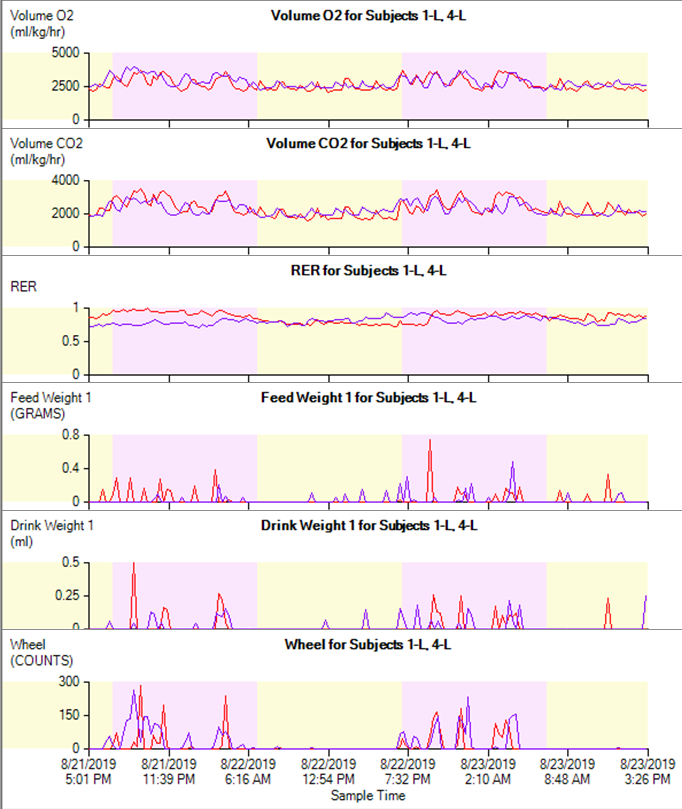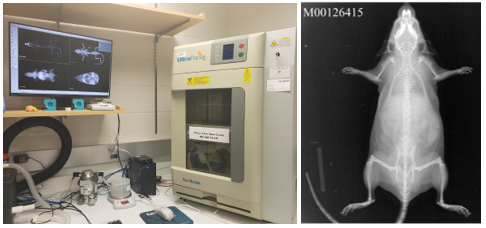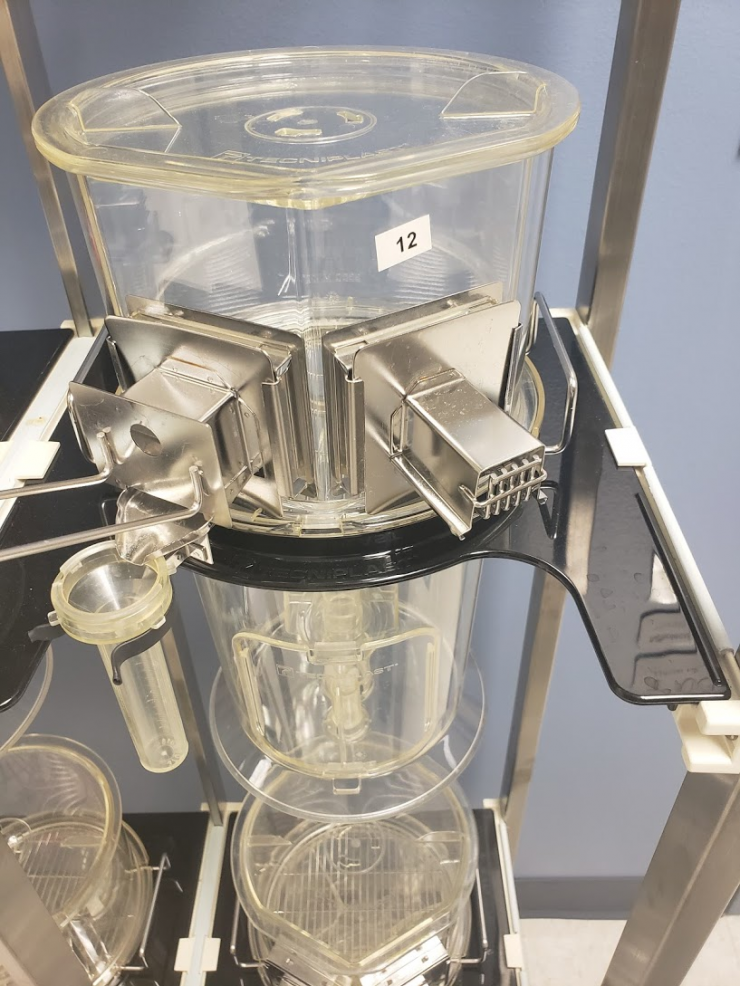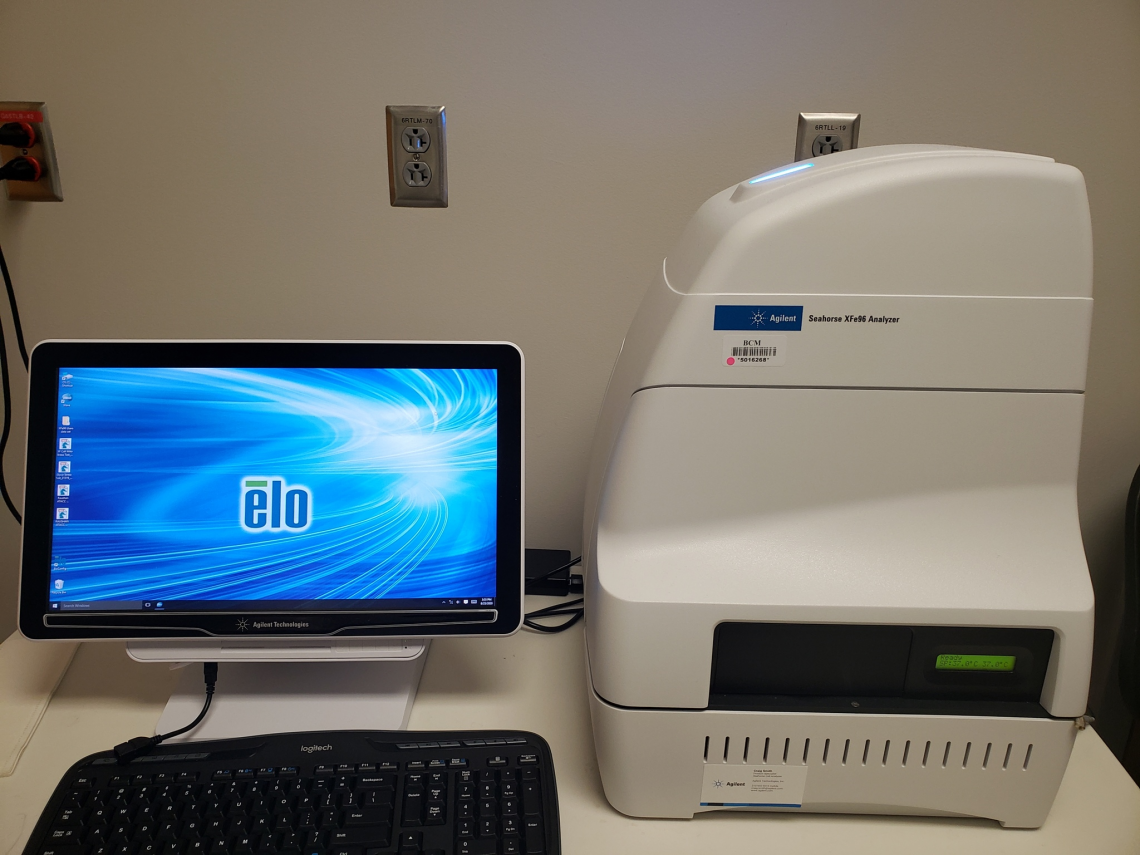CLAMS

Columbus Instruments CLAMS HC
- Indirect Calorimetry
- VO2
- VCO2
- RER
- Heat (kcal)
- Photobeam Activity
- Wheel Running
- Food Consumption
- Water Consumption
- Automated Feeding Restriction (timed or linked)
- Temperature Controlled Housing (4C - 45C)
- Adjustable Light Cycle

DEXA Body Composition Analysis (X-Ray based body composition)
- Dual Energy X-Ray Absorptiometry (DEXA) for body composition and Bone Mineral Density
- Percent Fat
- Percent Lean
- Perent Bone
- mg/cm2 (bone density)
EchoMRI (NMR based body composition)
EchoMRI 100
- NMR based analysis for body composition
- Fat Content
- Lean Content
- Water Content
Indirect Calorimetry
Columbus Instruments OxyFast
- Indirect Calorimetry
- VO2
- VCO2
- RER
- Heat (kcal)
- High frequency monitoring (up to one sample per minute from up to eight mice at a time)
- Chambers can be used for short sessions or up to 24 hour recordings if mice have access to food and water
- System can be connected to treadmills to monitor animals during an exercise challenge

Tecniplast Metabolic Cages
- Monitor Food and Water Consumption
- Monitor Urine and Feces Production
Glucose and Insulin Tolerance Testing
Glucose Tolerance Test (Oral or IP) with insulin:
- Test Description: After 6 hours or overnight fast animals are given 50% glucose via oral gavage or IP injection at 1~2.0g/kg. Blood samples are collected prior to and after the gavage/injection at time 0, 15, 30, 60, and 120 minutes via tail vein bleeding using lancet. Blood levels of glucose are measured based on glucose hexokinase assay and plasma levels of insulin are determined using Millipore rat/mouse insulin ELISA kit. Animals are restrained repeatedly for less than a minute each time while blood samples are collected.
Glucose Tolerance Test (Oral or IP) with blood collect but w/o insulin:
Glucose Tolerance Test (Oral or IP) without blood collection:
Insulin Tolerance Test:
- Test Description: After 4 hours of fasting, define dose of insulin (0.75 to 1.5 U/Kg body weight; Humulin R) is injected IP to mice. Blood glucose is measured at 0 (before) and after 15, 30, 60 and 120 minutes of insulin injection using a glucometer (Life Scan).
Pyruvate Tolerance Test (Gluconeogenesis):
- Test Description: We perform pyruvate challenge as a measure of gluconeogenesis. Mice are fasted overnight to deplete the liver of glycogen. Freshly prepared sterile pyruvate solution (20%) in saline [2g/kg or 1g/kg body weight] is injected IP. Blood glucose is measured at time 0, 15, 30, 60 and 120 minutes by using a glucometer.
Fat Tolerance Test, (Oral gavage, olive or corn oil)
- Test Description: After 5 hours fast, animals are given olive oil via oral gavage at 5~10 μl/g. BW. Blood samples are collected prior to and after the gavage at time = 0, 1, 2, 3, 4, 5, 6, and 8 hours via tail vein bleeding. Blood levels of NEFA and TG are measured enzymatically.
Hepatic TG Secretion (Poloxamer 407 or Triton WR-1339)
- Test Description: After 5 hours fast to minimize the contribution of postprandial lipid to the plasma TG concentrations, animals are given lipoprotein lipase inhibitor, poloxamer 407 (1000 mg/kg) or Triton WR-1339 (500 mg/kg) by tail injection. Blood samples are collected prior to and after the injection at time = 1, 2, 4, 8, and 24 hours via tail vein bleeding. Blood levels of TG are measured using an enzymatic assay.
Body Temperature Measurement
Rectal thermometer and implanted telemetry options available
- Monitor body temperature (rectal thermometer, implanted telemetry options also available for monitoring core body temperature)
Routine Blood Parameter Screening
Blood plasma/serum analysis (from as little as 5ul of sample per assay):
- Glucose, Cholesterol, TG, FFA, Glycerol, HDL, LDL, Insulin, Leptin, Adiponectin, BUN, Creatinine, Albumin, AST, ALT, ALP, Total bilirubin
Home Cage Monitoring
Photobeam activity monitoring of home cage activity
- Assess locomotor activity
- Look for circadian variation in activity
Cellular O2 Consumption and Glycolysis Monitoring (Agilent Seahorse XF24 or XFe96)
Agilent Seahorse XF24 or XFe96
- 24 and 96 well plate format
- Assess metabolic function, glycolysis/respiration in cultured cells
Hyperinsulinemic Clamp
Hyperinsulinemic euglycemic or hypoglycemic clamp (no tracer)
- Measure GIR (glucose infusion rate) and assess insulin sensitivity
Hyperinsulinemic euglycemic clamp to
- Assess insulin sensitivity using tracer (3H) to measure BGP, HGP, GDR, GIR
Hyperinsulinemic euglycemic clamp to
- Assess insulin sensitivity using tracer (3H) and tissue specific glucose uptake (using 14C)
Lipid Analysis
In vivo lipolysis to check fat breakdown ability from storage fat:
- Test Description: White adipose tissue releases fatty acids from stored triacylglycerol into circulation, which provides an energy source for other tissues. Dysregulated lipolysis may contribute to the pathophysiology of diabetes and related metabolic disorders. We inject IP either β3-specific agonist CL 316243 or a nonspecific β agonist Isoproterenol (0.1 mg/ kg) in 4 hr-fasted mice followed by blood collection at baseline and 15 minutes. The plasma glycerol and non-esterified fatty acids (NEFA) levels are quantified using commercial assay kits
Triglyceride clearance assay
- Test Description: TG clearance by the liver is an important measure of its ability to maintain energy expenditure. We inject 0.25 ml of intralipid through the tail vein of mice and measured the plasma TG concentration every 30 min over 4 hours to get the TG clearance profile.
Lipogenesis in vivo
- Test Description: Hepatic lipogenesis is a key factor regulating overall energy expenditure. In vivo lipogenesis will be measured by injecting tritiated water (23,24). Mice will be trained to feed during 3-h periods from 8 to 11 a.m. every day for 2 weeks. On the day of the experiment, after a 3-h feeding, they are fasted for 1 h before receiving an intraperitoneal injection of 2 mCi of tritiated water. Mice are sacrificed after another hour. The liver is removed and 300 mg is minced and used for lipid extraction in saponification solution containing 45% KOH-H2O-70% ethanol (2:1:5) at 80°C for 3 h. Water is added and the mixture is extracted three times with 8 ml of petroleum ether. The top petroleum-soluble phase is pooled and dried under a fume hood before digitonin addition to precipitate cholesterol for quantitative analysis. The bottom alkaline aqueous phase containing saponified fatty acid (FA), will acidify by the addition of 1.25 ml of 10 N H2SO4 followed by three extractions with petroleum ether. The pooled petroleum-soluble phase is air dried hood and then dissolved in chloroform for analysis by TLC and radioactivity measurement.
Lipid Profiling by HPLC separation of plasma: VLDL, HDL, LDL peak analysis
Lipid Extraction from any tissue
In vivo Flux Analysis
Stable Isotope Infusion and Mass Spectrometry Analysis
- Trace the fate of fatty acids, glucose, or other isotopomeric substrates within the living animal
- Stable isotopic tracer infusions until a steady state level (maximum up to 6 hrs)
- Mass Spectrometry to analyze carbon flux through metabolic cycles









